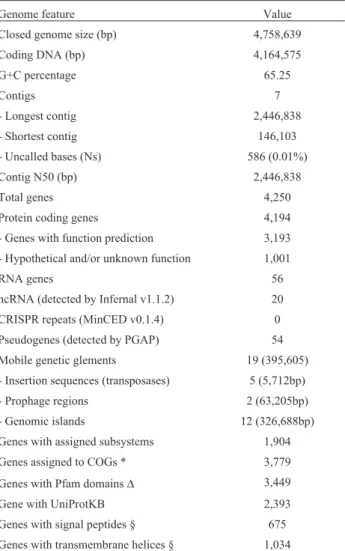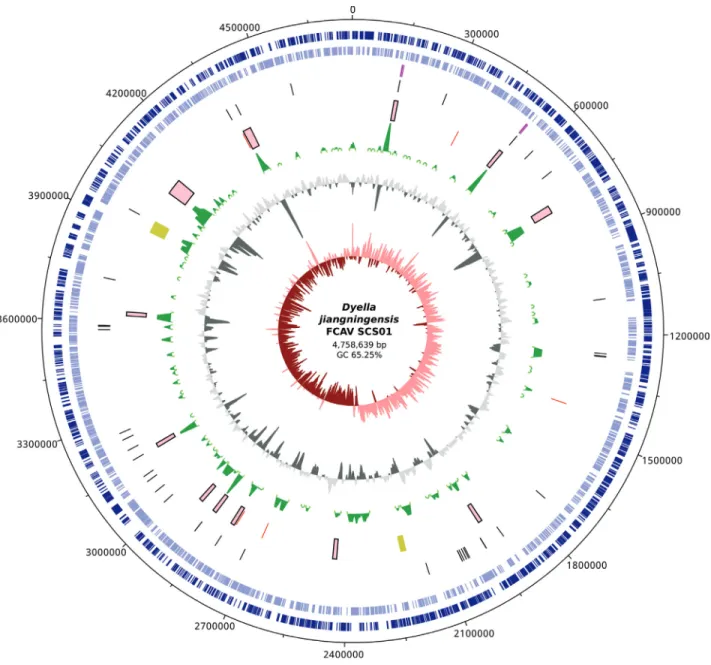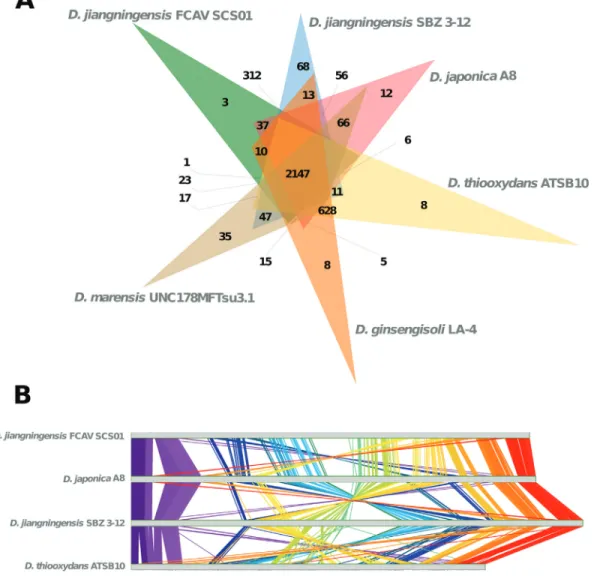The genome sequence of
Dyella jiangningensis
FCAV SCS01 from a
lignocellulose-decomposing microbial consortium metagenome reveals
potential for biotechnological applications
Joana G. Desiderato
1, Danillo O. Alvarenga
1, Milena T.L. Constancio
1, Lucia M. C. Alves
1and
Alessandro M. Varani
11
Departamento de Tecnologia, Faculdade de Ciências Agrárias e Veterinárias, Universidade Estadual
“Júlio de Mesquita Filho” (UNESP), Jaboticabal, SP, Brazil.
Abstract
Cellulose and its associated polymers are structural components of the plant cell wall, constituting one of the major sources of carbon and energy in nature. The carbon cycle is dependent on cellulose- and lignin-decomposing micro-bial communities and their enzymatic systems acting as consortia. These micromicro-bial consortia are under constant ex-ploration for their potential biotechnological use. Herein, we describe the characterization of the genome ofDyella jiangningensis FCAV SCS01, recovered from the metagenome of a lignocellulose-degrading microbial consortium, which was isolated from a sugarcane crop soil under mechanical harvesting and covered by decomposing straw. The 4.7 Mbp genome encodes 4,194 proteins, including 36 glycoside hydrolases (GH), supporting the hypothesis that this bacterium may contribute to lignocellulose decomposition. Comparative analysis among fully sequenced Dyella species indicate that the genome synteny is not conserved, and that D. jiangningensis FCAV SCS01 carries 372 unique genes, including an alpha-glucosidase and maltodextrin glucosidase coding genes, and other potential biomass degradation related genes. Additional genomic features, such as prophage-like, genomic islands and puta-tive new biosynthetic clusters were also uncovered. Overall,D. jiangningensis FCAV SCS01 represents the first
South AmericanDyella genome sequenced and shows an exclusive feature among its genus, related to biomass
degradation.
Keywords: Plant cell wall polysaccharides, glycoside hydrolases, genome annotation, comparative genomics, Rhodanobacteraceae.
Received: May 23, 2017; Accepted: September 13, 2017.
Plant cell wall structural molecules are primarily rep-resented by cellulose and its associated polymers, such as hemicellulose and lignin. These organic components are very stable and robust, protecting plant cell contents from the environment. Additionally, these polysaccharides are important sources of carbon and energy which are con-stantly accumulated and released into the environment dur-ing plant development or human manipulation by agricul-ture. While on an industrial scale the cellulosic material is commonly used for the development of wood, paper and others derivatives, in nature it is assimilated and cycled through cellulose- and lignin-degrading microbial commu-nities, which are the main keepers of carbon and energy cy-cles on a global scale (Bayeret al., 2013). These communi-ties are commonly referred to as microbial consortia, due to their abilities to work in cooperation to degrade and or me-tabolize compounds.
Although interactions between microbial consortia and the environment have been occurring for billions of years, only during the past decades have the lignocellulose degrading enzymatic systems been revealed, showing that a set of cellulolytic and non-cellulolytic glycoside hydrolases (GHs) are central players in the maintenance of the carbon cycle. Nowadays, these enzymes and the microorganisms responsible for their synthesis are constantly surveyed for their potential use in bioenergy and other industrial applica-tions – for instance, the conversion of cellulosic biomass into biofuels. However, efficient conversion of plant bio-mass to fermentable sugars remains challenging (Yanget al., 2009). In this context, we have evaluated the biotechno-logical potential ofDyella jiangningensis FCAV SCS01 (Xanthomonadales: Rhodanobacteraceae) through genome characterization. This bacterium was recovered from a lignocellulose-degrading microbial consortium metage-nome isolated from a sugarcane crop soil, which was under mechanical harvesting and covered by decomposing straw, in an ethanol fuel plant in the state of São Paulo, Brazil (21º 19S 48º 09W – 534.1m).
Send correspondence to Alessandro M. Varani. Departamento de Tecnologia, Faculdade de Ciências Agrárias e Veterinárias, Universidade Estadual “Júlio de Mesquita Filho” (UNESP). Via de Acesso Prof. Paulo Donato Castellane s/n, 14884-900 Jaboticabal, SP, Brazil. E-mail: amvarani@fcav.unesp.br.
Dyellais a gram-negative, rod-shaped bacterium that produces yellow colonies, originally found in soil, and
closely related to Frateuria, Rhodanobacter and
Fulvimonas genera from the Xanthomonadaceae family
(Xie and Yokota, 2005; Zhao et al., 2013). The D.
jiangningensisspecies was originally isolated from the sur-face of weathered potassic trachyte in China, exhibiting 97.9% 16S rRNA gene sequence similarity toDyella ja-ponica(Zhaoet al., 2013). The different species of this ge-nus exhibit a great diversity of biotechnologically-relevant features, such as mineral weathering, quorum-quenching activity, N-acylhomoserine lactone-degradation, thiosul-fate oxidation, beta-glucosidase activity and others, mostly related to plant interaction, bio-degradation and recycling processes (Anet al., 2005; Chen and Chan, 2012; Baoet al., 2014; Hwangboet al., 2016). In spite of their potential, this genus is still poorly studied in the genomics era. Ac-cording to the Genomes Online Database, among 13 public genome sequencing projects focused onDyellastrains to date, three correspond to species which had their genomes completely deciphered and 10 projects remain as perma-nent drafts or incomplete. It is worthy of note that most se-quencing projects carried out so far belong to isolates commonly found in the Asian continent, thus making the genome sequence ofD. jiangningensisFCAV SCS01 the first from South America, and that this genome also shows an exclusive feature among its genus, related to biomass degradation.
The consortium was cultivated in BHB medium with 0.1 g/mL cycloheximide and 0.5% sugarcane straw main-tained in weekly subcultures. Samples were extracted over 20 weeks for whole metagenome sequencing. A total of 69,482,643 reads (2x100 bp) were generated by the Illumina HiSeq 2500 platform using the Nextera XT DNA Sample Prep Kit and HiSeq v4 Reagent kits (Illumina), cor-responding to the entire consortium metagenome. Bases presenting Phred quality scores lower than 28, sequences shorter than 30 bp and adapter sequences were removed from the datasets with Trimmomatic 0.36 (Bolgeret al., 2014). Filtered reads were assembled with metaSPAdes 3.10.1 (Nurket al., 2017). The full assembled metagenome was then analyzed with Kraken 0.10.5 (Wood and Salz-berg, 2014) for the taxonomic assignment of sequences and ZEUSS 1.0.0 (Alvarengaet al., 2017) for the retrieval of identified genome sequences. A total of 17,201,619 paired-ends and 2,719,249 single-end reads were assem-bled into 7 scaffolds spanning 4,758,053 bp, with an N50 of
2,446,838 and L50 of 1, representing the Dyella
jiangningensisFCAV SCS01 genome (Table 1). These re-sults indicate that thisDyellagenome amounted to at least 24% of the sequenced metagenome reads. Further 16S rDNA based analysis show that the orders Burkholderiales (72.6%), Xanthomonadales (24.1%), Rhizobiales (2%), Gemmatales (0.8%), Actinomycetales (0.2%) and non clas-sified (0.3%) compose the consortium. In spite of higher
abundance, the Burkholderiales genomes were assembled in thousands of contigs, suggesting that different species may be present and making difficult the binning and assem-bly of each of these individuals.
Further analysis assisted by the SIS software (Diaset al., 2012), comparisons to genomic references from other completely sequenced Dyella genomes (Table S1), and alignments of concordant paired reads allowed the recon-struction of two copies of the rRNA operon and the closing of theDyellagenome into a single scaffold containing 586 uncalled bases, representing a circular and nearly complete genome. The G+C percentage in the FCAV SCS01 genome (65.25%) and the GC Skew plot were also similar to the patterns of the currently available reference genomes. Fea-tures of the closed genome of D. jiangningensis FCAV SCS01 are illustrated in Figure 1.
Genome annotation performed with the RAST server (Overbeeket al., 2014) and the NCBI Prokaryotic Genome
508 Desideratoet al.
Table 1- Genomic features ofDyella jiangningensisFCAV SCS01.
Genome feature Value
Closed genome size (bp) 4,758,639
Coding DNA (bp) 4,164,575
G+C percentage 65.25
Contigs 7
- Longest contig 2,446,838
- Shortest contig 146,103
- Uncalled bases (Ns) 586 (0.01%)
Contig N50 (bp) 2,446,838
Total genes 4,250
Protein coding genes 4,194
- Genes with function prediction 3,193
- Hypothetical and/or unknown function 1,001
RNA genes 56
ncRNA (detected by Infernal v1.1.2) 20
CRISPR repeats (MinCED v0.1.4) 0
Pseudogenes (detected by PGAP) 54
Mobile genetic glements 19 (395,605)
- Insertion sequences (transposases) 5 (5,712bp)
- Prophage regions 2 (63,205bp)
- Genomic islands 12 (326,688bp)
Genes with assigned subsystems 1,904
Genes assigned to COGs * 3,779
Genes with Pfam domainsD 3,449
Gene with UniProtKB 2,393
Genes with signal peptides § 675
Genes with transmembrane helices § 1,034
* Including General function prediction only (R) and Function unknown (S).
DIncluding domain of unknown function (DUF).
Annotation Pipeline (Tatusovaet al., 2016) predicted a to-tal of 4,250 genes. Among these genes, 56 encoded RNA molecules and 20 were involved in the synthesis of non-coding RNA, while 54 were pseudogenes. While hypothet-ical or unknown functions were assigned to 1,001 genes, 2,825 genes were identified in subsystems. The genome functional summary, characteristics and features are shown in the Table 1, and in more detail in Tables S2 and S3.
A total of 36 GHs were identified inD. jiangningensis
FCAV SCS01 (Table 2). In addition, the FCAV SCS01 ge-nome harbors an exclusive copy of the cellulolytic en-zymes: maltodextrin glucosidase and alpha-glucosidase. These enzymes may be involved with the rapid hydrolysis
of the sugarcane straw, supporting the hypothesis that this bacterium may contribute to lignocellulose decomposition.
Few mobile genetic elements (MGE) clusters were identified using the current protocol by (Alvarengaet al., 2018). The MGEs are spread over the entire genome, and are related to five insertion sequence regions, mostly be-longing to the IS2 ssgr IS51 family, two incomplete and de-generated prophage regions and 12 potential genomic islands (GIs). In general, the GIs encode genes related to the general metabolism; nonetheless, antibiotic and multi-drug resistance, type IV secretion systems and others not directly related to biomass degradation were identified (for a full list please see Table S4). antiSMASH 4.0.0rc1 (Blin
et al., 2017) was used for predicting gene clusters poten-tially involved in the biosynthesis of secondary metabo-lites, and uncovered clusters coding for novel aryl-polyene, bacteriocin, and terpene molecules, in addition to the prod-ucts of a hybrid non-ribosomal peptide synthetase and polyketide synthase pathway. However, the predicted gene clusters presented low or no similarity to biosynthetic clus-ters described for known molecules, suggesting that this strain might also be a source of novel chemicals. It is wor-thy to mention that none of these clusters were included in the MGEs clusters.
Comparative analyses among closely related and dif-ferentDyellaspecies indicated that the FCAV SCS01 pro-tein coding regions show 90.77%, 78.37%, 70.35%, 65.60%, 65.35% of identity toD. jiangningensisSBZ 3-12,
D. japonica A8, D. marensis UNC178MFTsu3.1, D. thiooxydans ATSB10 and D. ginsengisoli LA-4,
respec-tively. Moreover, the 16S rRNA gene in this strain is 99% identical to that ofD. jiangningensisSBZ 3-12, thus cor-roborating the taxonomic identification. In addition, these species share 2,147 orthologous clusters (Figure 2A). How-ever, despite the high number of orthologous clusters, ge-nome collinearity is not conserved among the completely sequenced species, whereas several inversions and translocations were observed (Figure 2B).
Despite finding only three orthologous clusters re-lated to unknown proteins exclusive to FCAV SCS01, this genome also harbors 372 unique genes. Most of these genes correspond to hypothetical proteins (265). However, re-markable features, such as chemotaxis-related proteins, chitosanase, cytochrome c oxidase polypeptide I, II, III, and IV, and an almost complete copy of a conjugative trans-fer operon (traB,C,D,E,F,G,I,J,L) were identified. Poten-tial enzymes related to biomass degradation, like
hydro-510 Desideratoet al.
FCAV
SCS01
511
Enzymes EC number GH Family D. jiangningensis
FCAV SCS01
D. jiangningensis SBZ 3-12
D. japonicaA8 D. thiooxydans ATSB10
D. marensis UNC178MFTsu3.1
D. ginsengisoli LA-4 (Hemi)cellulose
Alpha-amylase 3.2.1.1 13, 14, 57, 119 1 1 1 1 1 1
Alpha-galactosidase 3.2.1.22 4, 27, 31, 36, 57, 97, 110 nf nf nf nf 1 nf
Alpha-galactosidase percursor 3.2.1.22 4, 27, 31, 36, 57, 97, 110 1 1 2 1 2 nf
Alpha-glucosidase 3.2.1.20 4, 13, 31, 63, 97, 122 2 (*) 1 nf nf nf nf
Alpha-glucuronidase 3.2.1.139 67 1 1 nf nf nf nf
Alpha-L-fucosidase 3.2.1.51 29, 95 3 3 4 nf 2 nf
Alpha-N-acetylglucosaminidase 3.2.1.50 89 1 1 1 1 1 nf
Alpha-1,2-mannosidase 3.2.1.24 31,38,92 7 8 4 3 4 3
Alpha-xylosidase 3.2.1.177 31 nf nf nf 1 nf nf
Beta-galactosidase 3.2.1.23 1, 2, 3, 35, 42, 50 3 3 2 2 3 nf
Beta-mannosidase 3.2.1.25 1, 2, 5 2 2 2 1 1 1
Beta-xylosidase 3.2.1.37 3,30,39,43,52,54 2 2 nf 1 2 nf
Endoglucanase 3.2.1.4 5, 6, 7, 9 ,12, 44, 45, 51, 74,124 nf nf 1 nf nf nf
Glucoamylase 3.2.1.3 15, 97 1 1 1 1 1 1
Trehalase 3.2.1.28 13,15,37,65 1 1 1 2 1 2
Malto-oligosyltrehalose trehalohydrolase
3.2.1.141 13 1 1 nf nf nf nf
Maltodextrin glucosidase 3.2.1.20 4, 13 2 (*) 1 nf nf nf nf
alpha-N-acetylgalactosaminidase 3.2.1.49 36 1 1 1 nf 1 nf
Xylanase 3.2.1.8 5, 8, 10, 11, 43 1 1 nf 2 1 nf
Endo-1,4-beta-xylanase A precursor 3.2.1.8 5, 8, 10, 11, 43 nf nf nf nf 1 nf
Chitin
Beta-hexosaminidase 3.2.1.52 3,5,18,20,84,116 4 3 4 1 3 1
Chitinase 3.2.1.14 18, 19 2 2 2 1 3 1
TOTAL GHs 36 34 26 19 28 10
lase, glycosyltransferase, and maltose transporter and maltose-specific TonB-dependent receptor, were also iden-tified (a full list of the unique features is shown in Table S5).
Overall, theDyella jiangningensisFCAV SCS01 ge-nome presents several relevant features, including enzymes which can be exploited for bioenergy production, therefore supporting its use in a number of biotechnological applica-tions. Since not all biomass degradation related enzymes were found in theDyellagenome, it is plausible that the mi-croorganisms present in the consortium might act synergis-tically for the biomass degradation. Therefore, this hypoth-esis, and the possible metabolic potential and ecological interactions between these microorganisms in the consor-tium will be evaluated in a future work. The annotated se-quences ofDyella jiangningensisFCAV SCS01 have been deposited in the DDBJ/EMBL/GenBank database under the accession number NFZS00000000. The version de-scribed in this paper is the first version.
Acknowledgments
This work was supported by a grant from the Conse-lho Nacional de Desenvolvimento Científico e Tecnológico (CNPq) to AV (#445994/2014-2) and Fundação de Am-paro a Pesquisa do Estado de São Paulo (FAPESP) to LA (#10/17520-9 and #16/16624-1). JD was supported by a CNPq master fellowship. AV thanks CNPq for a research fellowship (# 302599/2016-9).
References
Alvarenga DO, Fiore MF and Varani AM (2017) A metagenomic approach to cyanobacterial genomics. Front Microbiol 8:809.
Alvarenga DO, Moreira LM, Chandler M, Varani AM (2018) A Practical Guide for Comparative Genomics of Mobile Ge-netic Elements in Prokaryotic Genomes. In: Setubal J, Stoye J, Stadler P (eds) Comparative Genomics: Methods in Mo-lecular Biology. Humana Press, New York, pp 213-242. An DS, Im WT, Yang HC, Yang DC and Lee ST (2005)Dyella
koreensissp. nov., a beta-glucosidase-producing bacterium. Int J Syst Evol Microbiol 55:1625-1628.
Bao Y, Kwok AHY, He L, Jiang J, Huang Z, Leung FCC and Sheng X (2014) Complete genome sequence of Dyella jiangningensisstrain SBZ3-12, isolated from the surfaces of weathered rock. Genome Announc 2:e00416-14.
Bayer EA, Shoham Y and Lamed R (2013) Lignocellulose-decomposing bacteria and their enzyme systems. In: Rosenberg E, DeLong EF, Lory S, Stackebrandt E and Thompson F (eds) The Prokaryotes. Springer, Berlin Hei-delberg, pp 215-266.
Blin K, Medema MH, Kottmann R, Lee SY and Weber T (2017) The antiSMASH database, a comprehensive database of mi-crobial secondary metabolite biosynthetic gene clusters. Nu-cleic Acids Res 45:D555-D559.
Bolger AM, Lohse M and Usadel B (2014) Trimmomatic: A flexi-ble trimmer for Illumina sequence data. Bioinformatics 30:2114-2120.
Chen JW and Chan KG (2012) Genome sequence ofDyella ja-ponicaStrain A8, a quorum-quenching bacterium that de-grades N-acylhomoserine lactones, isolated from Malaysian tropical soil. J Bacteriol 194:6331.
Dias Z, Dias U and Setubal JC (2012) SIS: A program to generate draft genome sequence scaffolds for prokaryotes. BMC Bioinformatics 13:96.
Hwangbo K, Um Y, Chung H, Yoo J, Kim KY, Madhaiyan M, Sa TM and Lee Y (2016) Complete genome sequence ofDyella thiooxydans ATSB10, a thiosulfate-oxidizing bacterium isolated from sunflower fields in South Korea. Genome Announc 4:e00573-16
Nurk S, Meleshko D, Korobeynikov A and Pevzner PA (2017) meta.SPAdes: A new versatile metagenomic assembler. Ge-nome Res 27:824-834.
Overbeek R, Olson R, Pusch GD, Olsen GJ, Davis JJ, Disz T, Ed-wards RA, Gerdes S, Parrello B, Shukla Met al.(2014) The SEED and the Rapid Annotation of microbial genomes us-ing Subsystems Technology (RAST). Nucleic Acids Res 42:D206-D214.
Tatusova T, DiCuccio M, Badretdin A, Chetvernin V, Nawrocki EP, Zaslavsky L, Lomsadze A, Pruitt KD, Borodovsky M and Ostell J (2016) NCBI prokaryotic genome annotation pipeline. Nucleic Acids Res 44:6614-6624.
Treangen TJ and Messeguer X (2006) M-GCAT: Interactively and efficiently constructing large-scale multiple genome comparison frameworks in closely related species. BMC Bioinformatics 7:433.
Wang Y, Coleman-Derr D, Chen G and Gu YQ (2015) OrthoVenn: A web server for genome wide comparison and annotation of orthologous clusters across multiple species. Nucleic Acids Res 43:W78-W84.
Wood DE and Salzberg SL (2014) Kraken: Ultrafast meta-genomic sequence classification using exact alignments. Genome Biol 15:R46.
Xie CH and Yokota A (2005)Dyella japonicagen. nov., sp. nov., a gamma-proteobacterium isolated from soil. Int J Syst Evol Microbiol 55:753-756.
Yang SJ, Kataeva I, Hamilton-Brehm SD, Engle NL, Tscha-plinski TJ, Doeppke C, Davis M, Westpheling J and Adams MWW (2009) Efficient degradation of lignocellulosic plant biomass, without pretreatment, by the thermophilic anae-robe “Anaerocellum thermophilum” DSM 6725. Appl Envi-ron Microbiol 75:4762-4769.
Zhao F, Guo X, Wang P, He L, Huang Z and Sheng X (2013) Dyella jiangningensissp. nov., ag-proteobacterium isolated from the surface of potassium-bearing rock. Int J Syst Evol Microbiol 63:3154-3157.
Internet Resources:
GOLD: Genomes Online Database, https://gold.jgi.doe.gov (May 17, 2017)
Supplementary material
The following online material is available for this article: Table S1 - Publicly-availableDyellagenomes used in this study for comparative genomics.
Table S2 - Subsystems found in Dyella jiangningensis
FCAV SCS01 and other publicly available Dyella geno-mes.
Table S3 - Clusters of Orthologous Groups (COGs) found inDyella jiangningensisFCAV SCS01 and other publicly availableDyellagenomes.
Table S4 - Gene content of each MGE identified inDyella jiangningensisFCAV SCS01 complete genome.
Table S5 - The 371 exclusive genes found in Dyella
jiangningensisFCAV SCS01.
Associate Editor: Ana Tereza R. Vasconcelos


